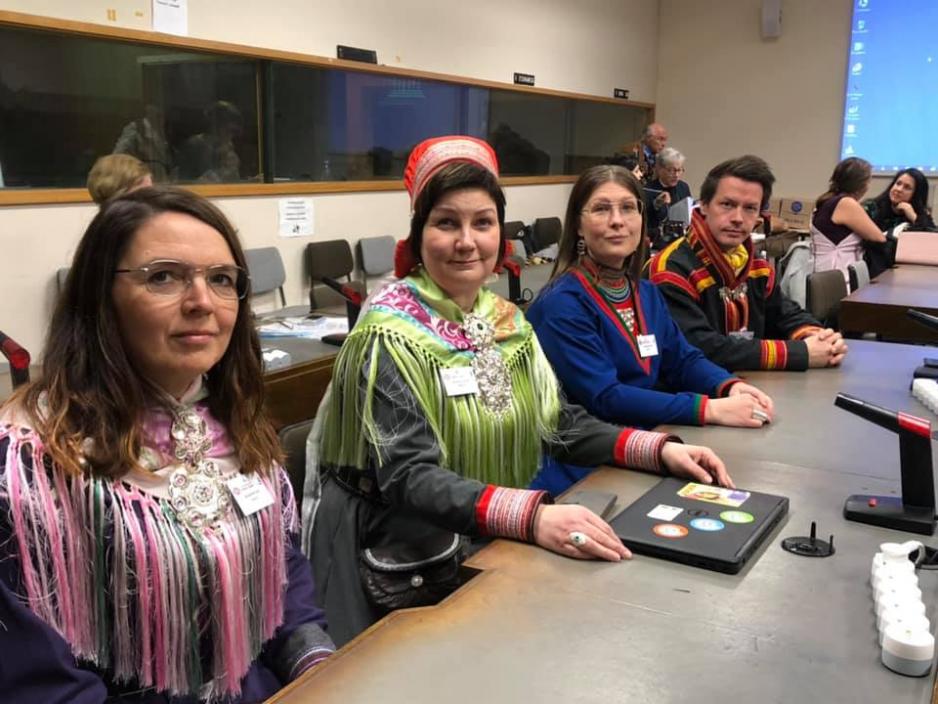How the new Sámi Arctic Strategy could shake up Arctic discourse
The document, released at last week's EU Arctic Forum, has a human-centered focus, rather than putting national interests in the foreground.

Åsa Larsson Blind, president of the Saami Council, launched The Sámi Arctic Strategy at the EU Arctic Forum last week in Umeå, Sweden.
The document’s full title is “The Sámi Arctic Strategy: Securing enduring influence for the Sámi people in the Arctic through partnerships, education and advocacy”. Following recent disputes on Saami land in Sweden and Finland linked to windfarm or rail-road construction plans the strategy is timely. It charts a path for future development drawing from Indigenous peoples’ values and perspectives.
The strategy should be read in the context of the 2017 EU Arctic Stakeholder Forum Sápmi Report on investment priorities and protection of Saami Peoples Rights in EU Investments. The new strategy document is 10 pages long with an attachment listing knowledge gaps and research needs. The strategy discusses six main points accompanied by measures to achieve them:
- The Saami Council acting as a robust and reliable partner on Arctic Sámi issues
- Ensuring the right to choose
- Addressing climate change and environmental protection
- Deploying Sámi Indigenous knowledge and science as a catalyst for Sápmi’s path forward
- Saami Council serving partner in policy-making and decision-making on Arctic issues
- The Saami Council as a partner in policy-making and decision-making on Arctic issues
What strategy brings to the Arctic discourse?
Unlike national Arctic strategies largely targeted at the protection of the national sovereign interests, Sámi Arctic Strategy is human-centered. “People” is the third most frequent word used in the document, after “Arctic” and “Council.”
The human aspect is tightly linked to Saami people rights: Sámi people’s right to self-determination now and for future generations and the right to say no and or to say yes to a project that may affect them or their territories secured in Prior and Informed Consent (FPIC) specific right from the United Nations Declaration on the Rights of Indigenous Peoples (UNDRIP). Right to self-determination includes the right to determine and develop priorities and strategies for the development or use of lands and other resources in Sápmi.
Special attention is paid to increased economic activity on Saami land. The strategy’s stance is that economic growth must be based on Sámi premises. There is no ambiguity in the language used: “resource development in Sápmi must be sustainable,” it reads, and “resource development must enhance, not detract from, Sámi food security.”
Knowledge should be at the cornerstone of any economic development, according to the strategy, which urges that “production of new knowledge (be) based on the needs of the people living in the Arctic.” Co-design and co-production of western and Indigenous knowledge is identified as a way forward. Sámi Indigenous knowledge is to be used when determining the sustainability of resource development initiatives.
Solutions to sustainable economic development
The document does not mention Arctic Investment Protocol as a solution to sustainable economic development. The strategy proposes Arctic Stewardship system including a certification mechanism to promote sustainable business behaviour in the Arctic.
What one can dissect from this statement is that the voluntary compliance initiatives and standards are unlikely to work in the Arctic. Better governance and accountability are needed. For instance, the strategy proposes to initiate a pilot project on climate-related financial disclosures in Arctic investments. The world already has a Task Force on Climate-Related Disclosures (TCFD) recommendations. It is a matter of choice if companies investing in the Arctic comply with them. Shall this type of reporting be compulsory is the right question to ask on a political level. Furthermore, the strategy recognizes the need to “develop standards for tourism on Sámi land that would ensure that Sámi communities benefit from increased human activity in this fragile environment.”
Other proposed initiatives for future development are a Sámi Business Summit and a toolkit for Sámi communities for natural resource projects on Indigenous land. Having a toolkit is not enough per se for community empowerment; it should be combined with training courses.
Knowledge gap
The attachment to the strategy is an excellent resource for the Arctic stakeholders. We still lack data and knowledge on e.g., Saami demography, cultural heritage and history, indigenous peoples’ rights connected to land and territories, animal health and ethics to name just a few from the list.
For researchers it gives direct guidance, what type of data is missing, what shall be studied next. For policymakers it lists challenges that shall be addressed. The list highlights topics relevant to creating research funding programs.
Way forward
Advocacy for human-centered, sustainable Arctic development respectful of environment is the main take from the document.
The approach can be applied to all local Arctic communities.
It a question of being heard and being listened to resulting in tangible Arctic economic solutions that governments and companies abide by. This could potentially change how we develop the Arctic for the future of humanity.